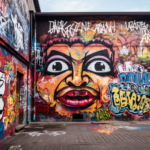In the realm of activism, few tools are as unapologetically bold and visually striking as graffiti. It transcends its role as mere street art and transforms into a potent weapon of protest and social commentary. Graffiti artists, with spray cans as their voice, wield this medium to speak out against injustice, challenge oppressive systems, and inspire change. In this exploration, we will delve into the world of graffiti as a powerful tool of activism and protest.
The Subversive Origins
Graffiti’s roots in activism can be traced back to its early days as a form of rebellion against societal norms and systems. It emerged as a voice for marginalized communities to express their discontent, reclaim their spaces, and demand equality.
Beyond Vandalism: The Transformation of Walls
Graffiti’s evolution from acts of vandalism to expressions of activism is a testament to its ability to adapt and convey messages that matter. Artists have elevated their work from mere tags to powerful statements that question authority, spotlight injustice, and challenge the status quo.
Graffiti’s Role in Protests
Graffiti often plays a central role in protests and social movements. It adorns protest signs, banners, and streets, providing a visual narrative of the issues at hand. Artists collaborate with activists to create impactful visuals that rally communities and capture the attention of the world.
The Global Language of Graffiti Activism
Graffiti activism knows no borders. Artists from diverse backgrounds and locations utilize this universal language to address local and global issues. We will explore examples from around the world, showcasing how graffiti bridges cultural divides and unites voices for change.
Themes of Activism
Graffiti as activism encompasses a multitude of themes:
- Social Justice: Murals that depict the struggle for racial equality, LGBTQ+ rights, and economic justice.
- Political Critique: Graffiti serves as a platform to criticize political leaders, policies, and institutions.
- Environmental Advocacy: Artists use their talents to draw attention to environmental crises, advocating for sustainability and conservation.
- Human Rights: Murals that highlight the importance of human rights, freedom of expression, and the fight against oppression.
The Impact of Graffiti Activism
We will examine how graffiti activism sparks conversations, influences public opinion, and empowers communities. From iconic pieces that became symbols of resistance to the role of graffiti in driving social change, we’ll explore its profound impact.
Challenges and Controversies
Graffiti activism is not without its challenges. Legal issues, property rights, and debates over the boundaries of free expression continue to shape the movement.
The Future of Graffiti Activism
As we conclude our exploration, we’ll contemplate the future of graffiti as a form of activism. How will it continue to evolve as a tool for change in an ever-shifting world? What role will it play in inspiring future generations of activists?
Join us on this journey through the powerful and transformative world of graffiti activism, where spray cans become agents of change and walls transform into canvases of justice and protest.




